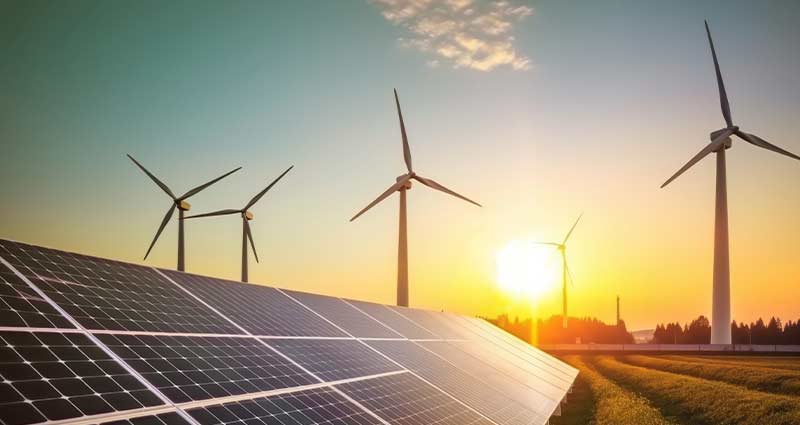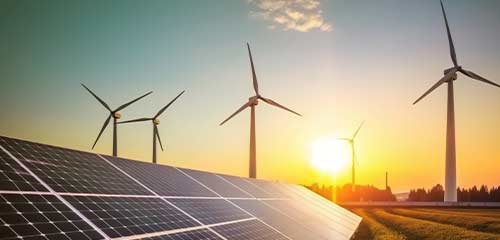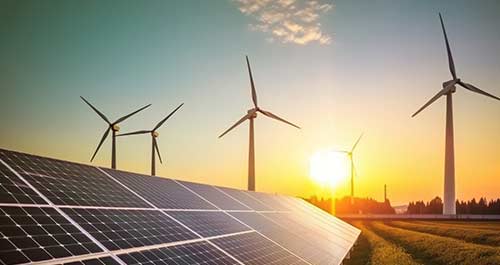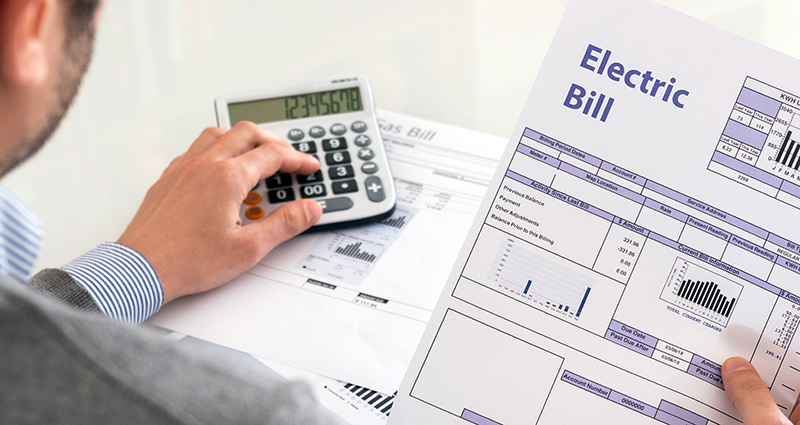How does solar energy work?
You may have seen solar panels on rooftops and even a solar farm, with acres and acres of black, shiny panels hoisted on racks. Inside these panels are photovoltaic cells, and their job is to turn light into electricity. These cells function, according to NASA, by transforming photons from sunlight into electrons.
When the electrons are passed through a semiconductor, it creates a current that can be made into electricity. Another less common form of solar energy is solar thermal, which concentrates the sun's rays on mirrors to heat a fluid (usually water). The steam from that fluid powers a turbine that makes electricity.
The state of solar power
In the ever-evolving landscape of renewable energy, solar power continues to experience significant growth. Over the past decade, material costs have seen a remarkable reduction of more than 60%, contributing to the affordability and widespread adoption of solar technology. This trend has garnered increased interest from individuals and jurisdictions alike, fostering a surge in solar installations globally.
Between 2015 and the most recent data in 2023, solar capacity has not only tripled but has continued to expand, solidifying its position as the fastest-growing source of electricity generation. As of the latest available information, the United States, a key player in the solar energy sector, boasts an impressive 162 gigawatts of solar capacity nationwide. This capacity is substantial, capable of supplying electricity to approximately 30 million homes.
Furthermore, the potential of solar power remains virtually limitless. According to the U.S. Department of Energy's latest assessments, harnessing solar energy by installing photovoltaic panels on just 0.6% of the nation's total land area could provide enough electricity to meet the entire energy needs of the United States. This emphasizes the vast untapped potential of solar energy and its crucial role in the transition to a more sustainable and renewable energy future.
In the dynamic landscape of solar power, it's noteworthy that 48% of all new electric capacity added to the grid in 2023 has originated from solar installations. While solar growth experienced a slowdown in 2022, with annual deployment 12% lower than in 2021, the industry has rebounded strongly in the first three quarters of 2023. Projections indicate that the solar sector is on track for another record-breaking year, with nearly 33 gigawatts of solar installations anticipated by the end of 2023.
For the most up-to-date information on solar power trends and statistics, you can refer to reputable sources such as the U.S. Department of Energy and Solar Energy Industries Association.
What are the advantages of solar energy?
When you stack the upsides to solar energy next to other energy sources, it has an impressive list of advantages:
- While solar systems take up land space, they don't always have to. Panels can be mounted on rooftops, making them well suited for urban areas.
- Rooftop solar also lends itself to distributed generation, as opposed to centralized, making for a more diverse and resilient electric grid.
- Solar is silent, which makes it ideal for more populated areas.
- There are no moving parts, and therefore it needs less maintenance than wind.
- The energy is easy to generate and transport.
- Panels work in cold climates, as air temperature doesn't matter as they catch rays.
- Home rooftop panels can reduce a homeowner's electricity costs. This would be an advantage during a heat wave for example, when energy loads are high.
- Once you install the panels, power generation is nearly free. You don't have to pay a penny for sunshine.
What are the challenges of solar energy?
Solar isn't a cure-all for our energy needs and has its limitations. You're only capturing energy during the daytime, and production levels can vary depending on how clear the sky is.
In addition, while battery technology is quickly advancing, we haven't yet found an optimal way to store the amounts of energy needed to power large population centers when the sun isn't offering optimal production. For now, we still rely on other energy sources on cloudy days or after dark, although a variety of promising storage systems are under development.
How does wind energy work?
Wind turbines generate electricity using similar principles as fossil fuel production, just using a different fuel source. If you look at the wind turbine, the electricity is being made at high altitude, right inside the cylinder shape behind the rotating blades. The wind pushes the blades into motion, which turns a shaft. This chain of motion eventually leads to a generator that makes electricity. The electricity then travels down the stem of the turbine and is taken to transmission lines to be transported and distributed to customers.
The state of wind energy
Presently, over 70,000 wind turbines are actively producing clean and dependable energy throughout the country. With a cumulative wind power capacity reaching 146 gigawatts, it stands as the fourth-largest contributor to the nation's electricity generation capacity. This extensive capacity equates to providing ample wind energy to power approximately 46 million American households.
What are the advantages of wind energy?
Wind energy also has an impressive list of advantages:
- Wind energy is a clean fuel source, meaning it doesn't pollute the air like power plants that rely on combustion of fossil fuels.
- Wind turbines can be built on farms and ranches, so leasing available land can become a source of income in rural areas while the owners can still use the land for other purposes.
- Wind power is cost-effective. Much like sunshine, wind costs nothing to produce.
- It's a domestic source of energy, and the nation's wind supply is abundant.
What are the challenges of wind energy?
The biggest problem wind production faces is the cost of transporting the energy generated, as the windiest areas are usually remote. In addition, like solar, wind is an intermittent power source, so you can't count on turbines to supply energy around the clock. Also, wind is less ideal for residential use for two reasons. One, turbines make noise. While the models are getting quieter, your home turbine may be frowned upon by neighbors, your homeowners association or even your city.
And in order to generate any significant amount of electricity, you would have to erect a taller turbine — up and away from wind-blocking buildings, trees and other urban obstacles. That too may not make you the most popular person on the block.
Other sources of renewable energy
Wind and solar aren't the only sources of renewable energy in play. Next, we'll explore hydroeletric power generation, geothermal energy, and biomass production.
Hydroelectric energy
Hydroelectric power remains a big player in electricity production in the United States, particularly in Washington, Oregon and California, and accounts for about 7% of energy generation in total. It works by using water to turn electricity-generating turbines and is reliable enough to supply base-load power for large areas of the country. Similar to wind and solar, the fuel source is free, and the production doesn't directly produce carbon emissions.
However, dams built to create hydroelectric reservoirs can be disruptive enough to river ecosystems upstream and down that some people question whether hydroelectric should truly be considered a green source of power at all. In addition, decomposing biomatter in areas flooded by dams can release significant carbon emissions and other contributors to climate change into the atmosphere. The final challenge is the effective capture of hydroelectric power also clearly depends on having a large volume of flowing water in the vicinity.
Geothermal energy
We can also capture and use heat for energy directly from the ground. On the household level, that can mean a pump that uses the difference in temperature between the air and the underground to heat your home. On a larger scale, we can use naturally occurring underground heat sources to produce electricity itself. Geothermal taps into a very sustainable resource — there is more heat than we could ever use within the Earth, and it is constantly being produced.
On the other hand, sending infrastructure deep underground is expensive to do, has the potential to emit certain harmful gases into the atmosphere and can also cause earthquakes. Efficient use of geothermal energy also depends on having a heat source close enough to the Earth's surface to exploit, which is only possible in certain areas of the world.
Biomass energy
Humans typically produce biomass energy by converting plant matter into heat or fuel. Your fireplace is a classic example of using biomass, and we also use it to fuel vehicles in the form of ethanol and biodiesel. On a large scale we can burn biomass to produce electricity. Biomass production can make use of otherwise unwanted byproducts like cornstalks, but it also takes away plant resources that would otherwise return nutrients to the soil, and production at any scale requires diverting land away from other uses.
Burning biomass also necessarily pumps carbon into the atmosphere, although this is considered less harmful than burning fossil fuels because it's short-term carbon already engaged in the global cycle which would be released when the plant dies and decays anyway, as opposed to burning oil or coal that would otherwise be trapped underground for millions of years. There are other methods of producing renewable energy that show promise, such as capturing the power of ocean waves and burning hydrogen molecules, but they haven't yet entered into widespread commercial use.
The future of renewable energy
It's important to know the difference between wind and solar energy, but fortunately we don't need to choose one over the other. All types of renewable energy can be used to complement each other, depending on what types of production are available in a given geographic location, and overcome the weaknesses of any one method.
Although the renewable energy industry has experienced great growth in the past decade, coal and natural gas are still generating the lion's share of the electricity for the United States. Even so, experts predict renewable energy will replace fossil fuels by 2050. In the meantime, watch for developments that will help renewables overcome their challenges of storage and capacity.


































